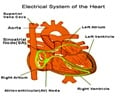Glossary
Atrium: (Plural: Atria) Blood collection chamber of the heart, into which blood enters from the veins. There are 2 atria in a human heart.Ventricle: Two chambers in the heart called ventricles are located just below their respective atrium. Blood is pushed into ventricle from the atrium and the ventricles, in turn, pump away the blood out into the arteries.
Bradycardia: Slow and rhythmic heart rate.
Tachycardia: Fast heart rate, usually rhythmic.
Arrhythmia: Abnormality in the rhythm of the heart.
Fibrillation: Unsynchronized and irregular contractions of the muscle fibers contained in the same muscle tissue.
Heart valves: The valves that are located in the heart that open to allow the blood to pass to the next chamber or blood vessel. The heart valves are the mitral (bicuspid) valve, tricuspid valve, two semilunar valves, pulmonary valve and the aortic valve.
Artery: The blood vessels forming the part of circulatory system carry oxygenated blood from the heart to all other parts of the body, except lungs.
Vein: The blood vessels that carry deoxygenated blood from other parts of the body to the heart. The pulmonary vein is the only vein that carries oxygenated blood to the heart.
Heart sound: The noises that are produced by the heart valves closure and the resultant blood flow through the heart chambers.
Hyperthyroidism: Overactive thyroid that produces excessive amounts of thyroid hormone.
Sinus tachycardia: Fast heart rate but with a consistent rhythm.









